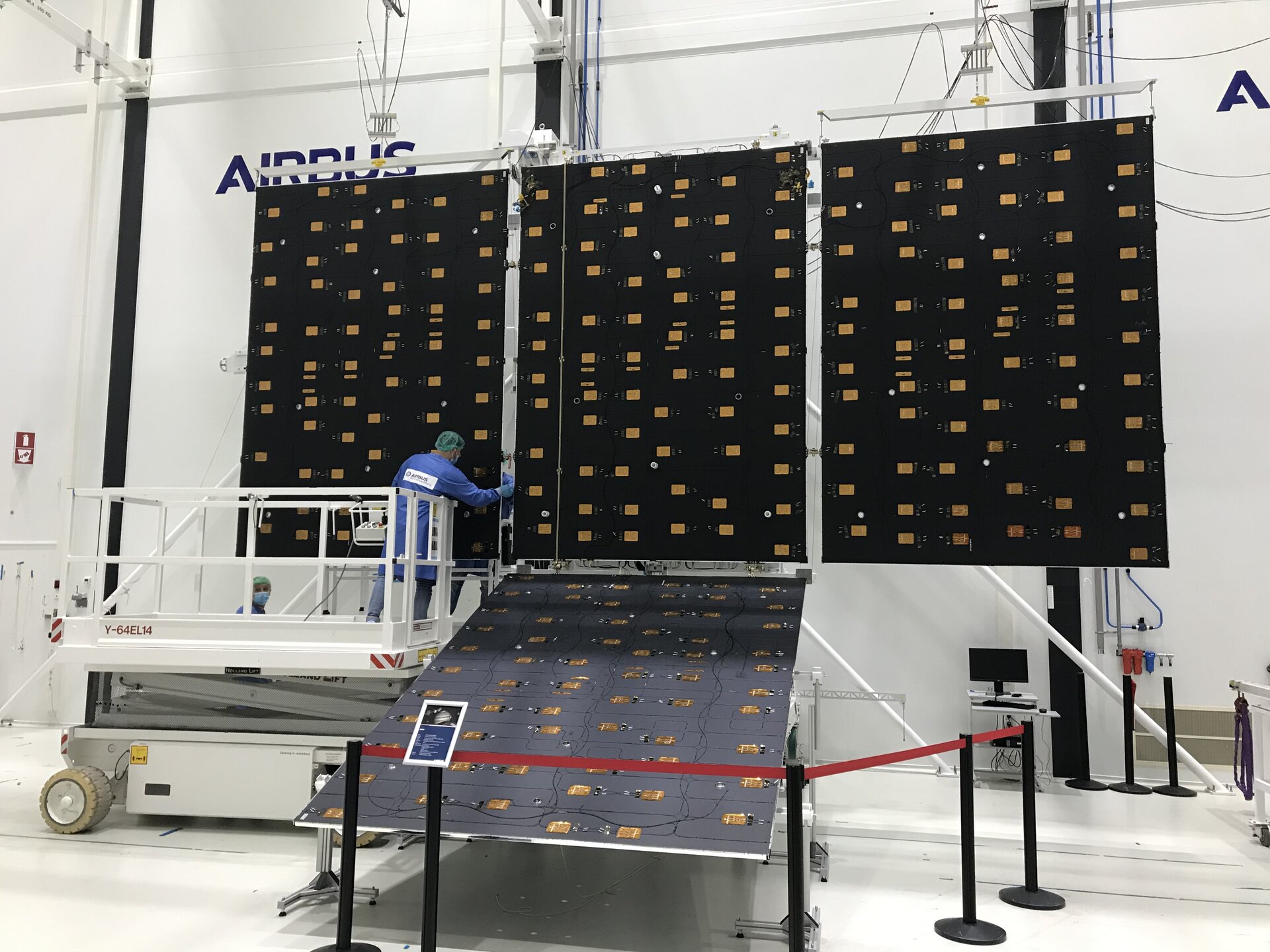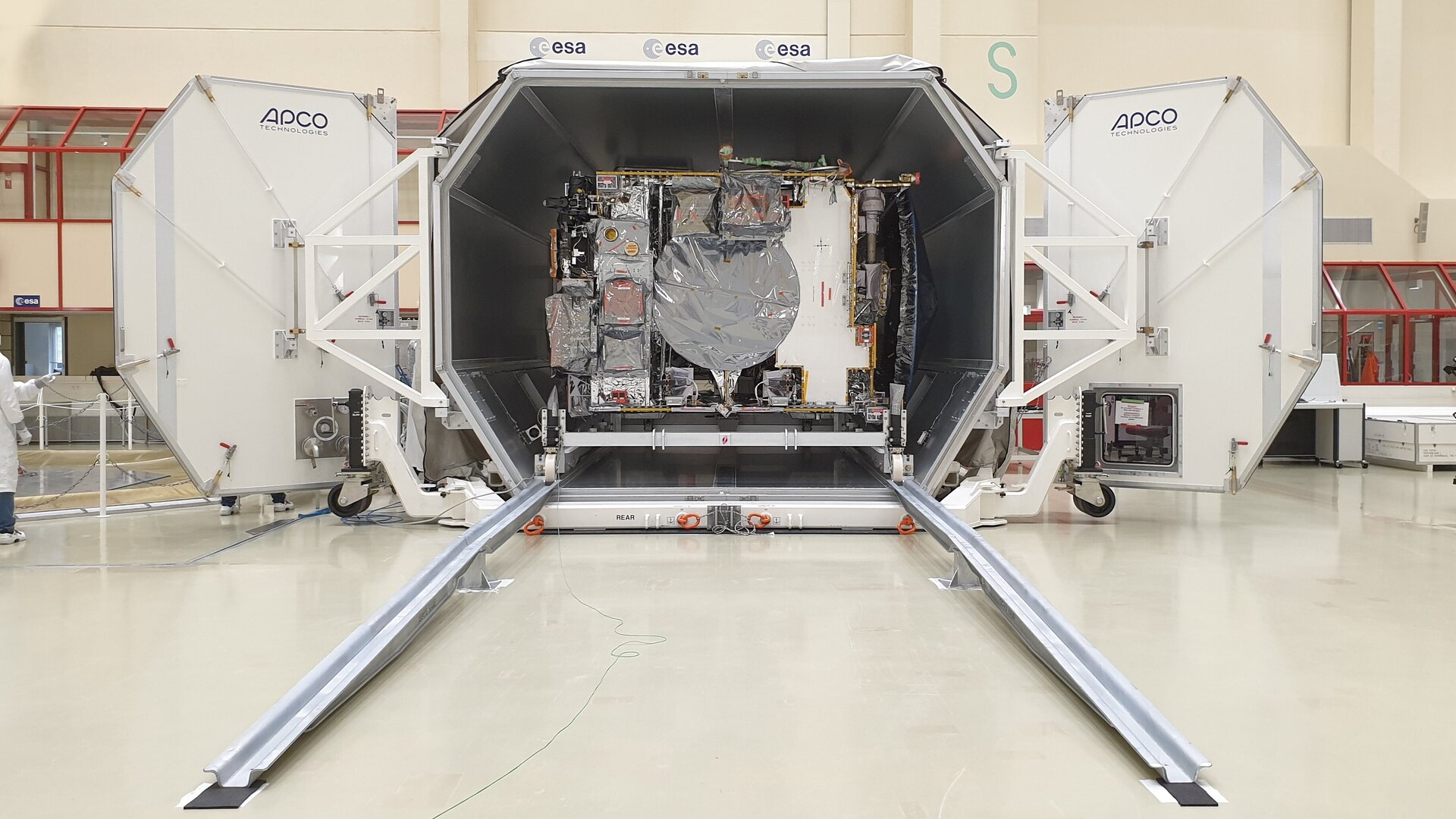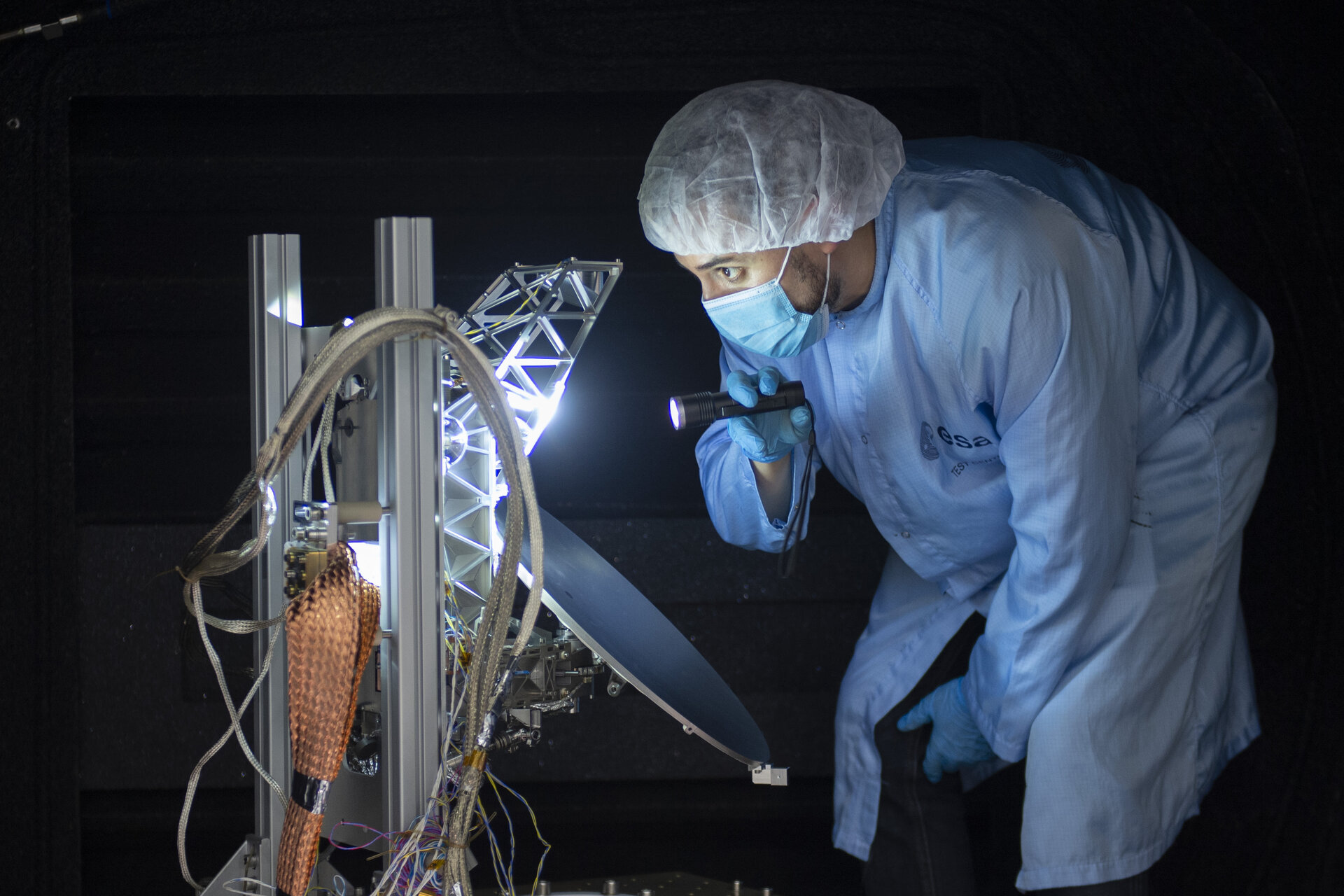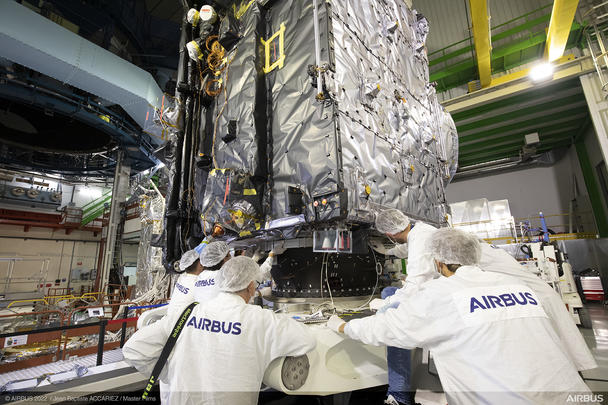You are using an out of date browser. It may not display this or other websites correctly.
You should upgrade or use an alternative browser.
You should upgrade or use an alternative browser.
ESA JUICE Mission
- Thread starter Flyaway
- Start date
- Joined
- 21 January 2015
- Messages
- 12,160
- Reaction score
- 16,376
FighterJock
ACCESS: Above Top Secret
- Joined
- 29 October 2007
- Messages
- 5,610
- Reaction score
- 5,941
Good news for JUICE, I cannot wait until it launches.
- Joined
- 21 January 2015
- Messages
- 12,160
- Reaction score
- 16,376
- Joined
- 21 January 2015
- Messages
- 12,160
- Reaction score
- 16,376

- Joined
- 21 January 2015
- Messages
- 12,160
- Reaction score
- 16,376
View: https://twitter.com/ESA_JUICE/status/1361250416374255617
ESA's JUICE mission said:Shaky moments for the 2.5m #JUICE High Gain Antenna, to make sure it will withstand the vibrations during launch into space ! @Thales_Alenia_S @AirbusSpace
- Joined
- 21 January 2015
- Messages
- 12,160
- Reaction score
- 16,376

JUICE Jupiter probe’s first taste of space
JUICE, the JUpiter ICy moons Explorer mission led by the European Space Agency (ESA), has left Airbus’ satellite integration centre in Friedrichshafen (Germany) and is now on its way to the Large Space Simulator (LSS) chamber of the European Space Agency (ESA) in Noordwijk (Netherlands) for its...
FighterJock
ACCESS: Above Top Secret
- Joined
- 29 October 2007
- Messages
- 5,610
- Reaction score
- 5,941

JUICE Jupiter probe’s first taste of space
JUICE, the JUpiter ICy moons Explorer mission led by the European Space Agency (ESA), has left Airbus’ satellite integration centre in Friedrichshafen (Germany) and is now on its way to the Large Space Simulator (LSS) chamber of the European Space Agency (ESA) in Noordwijk (Netherlands) for its...www.airbus.com
Good luck in the space simulator JUICE, let's hope that it passes all the tests and will be ready for launch.
- Joined
- 21 January 2015
- Messages
- 12,160
- Reaction score
- 16,376

Juice arrives at ESA’s technical heart
The Jupiter Icy Moons Explorer, Juice, has come ‘home’ to ESA’s technical centre in the Netherlands to undergo an extreme environment test in Europe’s largest thermal vacuum chamber to prepare for its journey to the outer Solar System.
www.esa.int
- Joined
- 21 January 2015
- Messages
- 12,160
- Reaction score
- 16,376
- Joined
- 21 January 2015
- Messages
- 12,160
- Reaction score
- 16,376

- Joined
- 21 January 2015
- Messages
- 12,160
- Reaction score
- 16,376
- Joined
- 21 January 2015
- Messages
- 12,160
- Reaction score
- 16,376
FighterJock
ACCESS: Above Top Secret
- Joined
- 29 October 2007
- Messages
- 5,610
- Reaction score
- 5,941
A highly interesting video Flyaway, thanks for posting.
- Joined
- 21 January 2015
- Messages
- 12,160
- Reaction score
- 16,376
Juice takes the heat
View: https://youtu.be/guZiP0dt2KQ
- Joined
- 21 January 2015
- Messages
- 12,160
- Reaction score
- 16,376
Last stop on Earth at Airbus before odyssey to Jupiter for JUICE
Final integration and test in Toulouse before 2022 launch to meet tight interplanetary schedule
Almost nine year journey for four year mission around Jupiter moons: could there be new life habitats?
Toulouse, 12 August 2021 – The Airbus-built JUICE spacecraft, (JUpiter ICy moons Explorer mission) developed for the European Space Agency (ESA) has arrived in Toulouse, where it will stay for its final assembly and test campaign at Airbus’ satellite integration centre, before being shipped to Kourou in French Guiana for launch on Ariane 5.
After three months of intense activities for thermal vacuum testing in the Large Space Simulator (LSS) chamber at the ESA test centre at ESTEC in Noordwijk, Netherlands, JUICE is back at Airbus, the prime contractor. Unusually, it was transported by air to Toulouse, to save time so that it remains on track to meet the tight interplanetary schedule to reach the Jovian system.
Cyril Cavel, JUICE project Manager at Airbus said on arrival: “It’s the first time I have seen a satellite arriving in Toulouse by plane, which shows the importance of this mission for ESA and the scientific community. Now we at Airbus have to build on the great work of all of our industrial and scientific partners. I can’t wait for this ambitious mission to launch and to see the tremendous progress to human knowledge it will bring – even though we will have to wait almost 10 years, before it arrives at Jupiter!”
Opening of the pressurized protective container and transfer to the clean room has already been completed. Airbus will now finalise the flight configuration assembly including integration of the last instrument units and the largest satellite solar arrays ever to fly for planetary exploration. Last but not least, the environmental tests, including electro-magnetic compatibility (EMC), mechanical, deployment, and propulsion, will continue through until next year in the run up to launch.
The 6.2 ton JUICE spacecraft will set off in 2022 on its near 600 million-kilometre long journey to Jupiter. The spacecraft will carry 10 state-of-the-art scientific instruments, including cameras, spectrometers, an ice-penetrating radar, an altimeter, a radio-science experiment, and sensors to monitor electric and magnetic fields and the plasma environment in the Jovian system. JUICE will complete a unique tour of the Jupiter system that will include in-depth studies of three potentially ocean-bearing moons: Ganymede, Europa and Callisto.
During its four year-long mission, JUICE will collect data to understand the conditions for giant gaseous planet formation and the emergence of deep life habitats. It will spend nine months orbiting the icy moon Ganymede analysing its nature and evolution, characterising its sub-surface ocean, and investigating its potential habitability.
As prime contractor for ESA, Airbus is leading an industrial consortium of more than 80 companies across Europe.

 www.airbus.com
www.airbus.com
Final integration and test in Toulouse before 2022 launch to meet tight interplanetary schedule
Almost nine year journey for four year mission around Jupiter moons: could there be new life habitats?
Toulouse, 12 August 2021 – The Airbus-built JUICE spacecraft, (JUpiter ICy moons Explorer mission) developed for the European Space Agency (ESA) has arrived in Toulouse, where it will stay for its final assembly and test campaign at Airbus’ satellite integration centre, before being shipped to Kourou in French Guiana for launch on Ariane 5.
After three months of intense activities for thermal vacuum testing in the Large Space Simulator (LSS) chamber at the ESA test centre at ESTEC in Noordwijk, Netherlands, JUICE is back at Airbus, the prime contractor. Unusually, it was transported by air to Toulouse, to save time so that it remains on track to meet the tight interplanetary schedule to reach the Jovian system.
Cyril Cavel, JUICE project Manager at Airbus said on arrival: “It’s the first time I have seen a satellite arriving in Toulouse by plane, which shows the importance of this mission for ESA and the scientific community. Now we at Airbus have to build on the great work of all of our industrial and scientific partners. I can’t wait for this ambitious mission to launch and to see the tremendous progress to human knowledge it will bring – even though we will have to wait almost 10 years, before it arrives at Jupiter!”
Opening of the pressurized protective container and transfer to the clean room has already been completed. Airbus will now finalise the flight configuration assembly including integration of the last instrument units and the largest satellite solar arrays ever to fly for planetary exploration. Last but not least, the environmental tests, including electro-magnetic compatibility (EMC), mechanical, deployment, and propulsion, will continue through until next year in the run up to launch.
The 6.2 ton JUICE spacecraft will set off in 2022 on its near 600 million-kilometre long journey to Jupiter. The spacecraft will carry 10 state-of-the-art scientific instruments, including cameras, spectrometers, an ice-penetrating radar, an altimeter, a radio-science experiment, and sensors to monitor electric and magnetic fields and the plasma environment in the Jovian system. JUICE will complete a unique tour of the Jupiter system that will include in-depth studies of three potentially ocean-bearing moons: Ganymede, Europa and Callisto.
During its four year-long mission, JUICE will collect data to understand the conditions for giant gaseous planet formation and the emergence of deep life habitats. It will spend nine months orbiting the icy moon Ganymede analysing its nature and evolution, characterising its sub-surface ocean, and investigating its potential habitability.
As prime contractor for ESA, Airbus is leading an industrial consortium of more than 80 companies across Europe.

Last stop on Earth at Airbus before odyssey to Jupiter for JUICE
The Airbus-built JUICE spacecraft, (JUpiter ICy moons Explorer mission) developed for the European Space Agency (ESA) has arrived in Toulouse, where it will stay for its final assembly and test campaign at Airbus’ satellite integration centre, before being shipped to Kourou in French Guiana for...
FighterJock
ACCESS: Above Top Secret
- Joined
- 29 October 2007
- Messages
- 5,610
- Reaction score
- 5,941
Last stop on Earth at Airbus before odyssey to Jupiter for JUICE
Final integration and test in Toulouse before 2022 launch to meet tight interplanetary schedule
Almost nine year journey for four year mission around Jupiter moons: could there be new life habitats?
Toulouse, 12 August 2021 – The Airbus-built JUICE spacecraft, (JUpiter ICy moons Explorer mission) developed for the European Space Agency (ESA) has arrived in Toulouse, where it will stay for its final assembly and test campaign at Airbus’ satellite integration centre, before being shipped to Kourou in French Guiana for launch on Ariane 5.
After three months of intense activities for thermal vacuum testing in the Large Space Simulator (LSS) chamber at the ESA test centre at ESTEC in Noordwijk, Netherlands, JUICE is back at Airbus, the prime contractor. Unusually, it was transported by air to Toulouse, to save time so that it remains on track to meet the tight interplanetary schedule to reach the Jovian system.
Cyril Cavel, JUICE project Manager at Airbus said on arrival: “It’s the first time I have seen a satellite arriving in Toulouse by plane, which shows the importance of this mission for ESA and the scientific community. Now we at Airbus have to build on the great work of all of our industrial and scientific partners. I can’t wait for this ambitious mission to launch and to see the tremendous progress to human knowledge it will bring – even though we will have to wait almost 10 years, before it arrives at Jupiter!”
Opening of the pressurized protective container and transfer to the clean room has already been completed. Airbus will now finalise the flight configuration assembly including integration of the last instrument units and the largest satellite solar arrays ever to fly for planetary exploration. Last but not least, the environmental tests, including electro-magnetic compatibility (EMC), mechanical, deployment, and propulsion, will continue through until next year in the run up to launch.
The 6.2 ton JUICE spacecraft will set off in 2022 on its near 600 million-kilometre long journey to Jupiter. The spacecraft will carry 10 state-of-the-art scientific instruments, including cameras, spectrometers, an ice-penetrating radar, an altimeter, a radio-science experiment, and sensors to monitor electric and magnetic fields and the plasma environment in the Jovian system. JUICE will complete a unique tour of the Jupiter system that will include in-depth studies of three potentially ocean-bearing moons: Ganymede, Europa and Callisto.
During its four year-long mission, JUICE will collect data to understand the conditions for giant gaseous planet formation and the emergence of deep life habitats. It will spend nine months orbiting the icy moon Ganymede analysing its nature and evolution, characterising its sub-surface ocean, and investigating its potential habitability.
As prime contractor for ESA, Airbus is leading an industrial consortium of more than 80 companies across Europe.

Last stop on Earth at Airbus before odyssey to Jupiter for JUICE
The Airbus-built JUICE spacecraft, (JUpiter ICy moons Explorer mission) developed for the European Space Agency (ESA) has arrived in Toulouse, where it will stay for its final assembly and test campaign at Airbus’ satellite integration centre, before being shipped to Kourou in French Guiana for...www.airbus.com
Good luck JUICE, let’s hope that it has a safe journey to Jupiter. It will certainly be an interesting mission to watch after all the rumours about the possibility of life Europa.
FighterJock
ACCESS: Above Top Secret
- Joined
- 29 October 2007
- Messages
- 5,610
- Reaction score
- 5,941
The launch of this mission has been delayed until NET August 2023.
Any news as to what caused the delay? I hope that it wasn't anything to do with JUICE itself.
- Joined
- 21 January 2015
- Messages
- 12,160
- Reaction score
- 16,376
I haven’t seen any reason given as of time writing this.The launch of this mission has been delayed until NET August 2023.
Any news as to what caused the delay? I hope that it wasn't anything to do with JUICE itself.
- Joined
- 21 January 2015
- Messages
- 12,160
- Reaction score
- 16,376
Winner of the JUICE up your rocket! art competition
Congratulations to Yaryna (8) from Ukraine, the winner of the JUICE up your rocket! art competition. Her piece will decorate the rocket that will launch JUICE on its mission to Jupiter!
Related article: Children of the world join Europe’s mission to Jupiter
Congratulations to Yaryna (8) from Ukraine, the winner of the JUICE up your rocket! art competition. Her piece will decorate the rocket that will launch JUICE on its mission to Jupiter!
Related article: Children of the world join Europe’s mission to Jupiter
FighterJock
ACCESS: Above Top Secret
- Joined
- 29 October 2007
- Messages
- 5,610
- Reaction score
- 5,941
JUICE will be on the final ever Ariane 5 launch in August 2023.
It will be the end of an era with the last launch of the Ariane 5 rocket.
- Joined
- 21 January 2015
- Messages
- 12,160
- Reaction score
- 16,376
ESA JUICE mission's flight plan to Jupiter & its moons
View: https://youtu.be/SQ6a8wZHhL0
ESA's Jupiter Icy Moons Explorer (JUICE) mission will arrive at the gas giant planet in 2031 and make flybys of its moons Europa, Callisto and Ganymede. See highlights of the flight in this animation.
- Joined
- 21 January 2015
- Messages
- 12,160
- Reaction score
- 16,376
#JUICE, the Jupiter Icy Moons Explorer of @esa, has passed a series of electromagnetic compatibility tests in the anechoic chamber.
Next step: solar array deployment and mechanical tests...
View: https://twitter.com/AirbusSpace/status/1517121741084110848
FighterJock
ACCESS: Above Top Secret
- Joined
- 29 October 2007
- Messages
- 5,610
- Reaction score
- 5,941
#JUICE, the Jupiter Icy Moons Explorer of @esa, has passed a series of electromagnetic compatibility tests in the anechoic chamber.
Next step: solar array deployment and mechanical tests...
View: https://twitter.com/AirbusSpace/status/1517121741084110848
Things are looking good for JUICE. Let's hope that the next tests goes as planned.
- Joined
- 21 January 2015
- Messages
- 12,160
- Reaction score
- 16,376
#JUICE is fully integrated and going through extensive testing. A good summary of this important milestone in the preparation for launch next year !
View: https://twitter.com/ESA_JUICE/status/1528654717038956544
JUICE will be on the final ever Ariane 5 launch in August 2023.
It will be the end of an era with the last launch of the Ariane 5 rocket.
Proton, EELVs too... they are falling like flies.
You say it like it's a bad thing (at least EELV, full disclosure I worked on it). It would be if what replaced it cost more and was less reliable...Proton, EELVs too... they are falling like flies.
- Joined
- 21 January 2015
- Messages
- 12,160
- Reaction score
- 16,376
Solar array deployment of JUICE spacecraft - DONE
10 solar panels (5 on each side) each measuring 2.5 m x 3.5 m with a total area of approx. 85 square metres These solar panels will provide the necessary power to run the spacecraft and operate the science instruments.
View: https://twitter.com/AirbusSpace/status/1532289634276884483
- Joined
- 21 January 2015
- Messages
- 12,160
- Reaction score
- 16,376
The structural tests of the @ESA_JUICE spacecraft are finished as well as the reduced functional tests afterwards. GALA and all other instruments are nominal. The picture shows the GALA TRU and its radiator (white rectangle).
View: https://twitter.com/GALA_JUICE/status/1546475961088090119
- Joined
- 21 January 2015
- Messages
- 12,160
- Reaction score
- 16,376
View: https://twitter.com/airbusspace/status/1585541745399439362
That's what you call power!️
10 panels, 26 980 cells, and a surface area of over 85 sqm: the solar arrays for @ESA_JUICE are the largest ever built for an interplanetary mission.
They’ve just been put to the test for the last time.
- Joined
- 21 January 2015
- Messages
- 12,160
- Reaction score
- 16,376
How do we verify that #JUICE will correctly measure the magnetic fields of #Jupiter, its icy moons & their complex interaction?
Look behind the scenes of the Magnetic Test Campaign in Episode 8 of "The Making of JUICE"!
View: https://twitter.com/ESA_JUICE/status/1581939260810153984
- Joined
- 21 January 2015
- Messages
- 12,160
- Reaction score
- 16,376
View: https://twitter.com/AirbusSpace/status/1603395053656891393
With launch only a few months away, @ESA_JUICE is undergoing its last round of tests!
The ️ was placed in a thermal vacuum chamber so that, by controlling both pressure & temperature, we could check its performance in space-like conditions. A first taste of what's to come!
- Joined
- 21 January 2015
- Messages
- 12,160
- Reaction score
- 16,376
JUICE interactive launch kit:
Juice launch kit
Download this launch kit (in English, other languages to come) to learn more about the Jupiter Icy Moons Explorer (Juice) mission and its science goals.
www.esa.int
- Joined
- 21 January 2015
- Messages
- 12,160
- Reaction score
- 16,376
Launch set for April 2023.

 www.airbus.com
www.airbus.com

Airbus finalises JUICE ready for its mission to Jupiter
The Airbus-built JUICE (JUpiter ICy moons Explorer mission) spacecraft will shortly leave Toulouse, France, for Kourou, French Guiana, for lift-off on an Ariane 5 in April 2023. Shipment is expected in early February.
20 January 2023
Space
Airbus finalises JUICE ready for its mission to Jupiter
Satellite ready to leave Europe before its launch in April
Galileo tribute plaque unveiled in Airbus’ cleanroom and mounted on the spacecraft
ESA’s mission will study Jupiter’s three largest icy moons and the Jovian system’s magnetic fields
Toulouse, 20 January 2023 - The Airbus-built JUICE (JUpiter ICy moons Explorer mission) spacecraft will shortly leave Toulouse, France, for Kourou, French Guiana, for lift-off on an Ariane 5 in April 2023. Shipment is expected in early February.
The spacecraft has been at Airbus in Toulouse since August 2021 for final assembly and test. This included integration of the final instrument units and the largest solar arrays ever to fly on a planetary exploration mission, needed to power the mission at 740 million kilometres from the Sun.
“With JUICE's departure for the launch site fast approaching, we look back at its long Earthly journey through various Airbus sites in Europe towards final integration and involving close to 500 Airbus employees who prepared the spacecraft for its eight-year cruise,” said Cyril Cavel, JUICE Project Manager at Airbus Defence and Space.
“It has been an incredible adventure, along with more than 80 companies across Europe, to bring ESA’s vision to life and ultimately study Jupiter and its icy moons in fine detail.”
Today a commemorative plaque was unveiled during a press event in Toulouse as a tribute to Italian astronomer Galileo Galilei. The plaque has been mounted on the spacecraft to honour Galileo who was the first to view Jupiter and its largest moons through a telescope in 1610.
On its more than 2 billion-kilometre long journey, the 6.2 ton JUICE spacecraft will collect data on the icy moons to try to understand whether there is any possibility that these moons could host microbial life. Carrying 10 state-of-the-art scientific instruments, including cameras, spectrometers, an ice-penetrating radar, an altimeter, a radio-science experiment, and sensors, the JUICE spacecraft will complete a unique tour of the Jupiter system that will include in-depth studies of three potentially ocean-bearing moons: Ganymede, Europa and Callisto.
During its four year-long mission, JUICE will spend nine months orbiting the icy moon Ganymede analysing its nature and evolution, characterising its subsurface ocean, and investigating its potential habitability.
After being selected by ESA as prime contractor in 2015 Airbus has led a pan European industrial consortium to design and build this unique spacecraft.
FighterJock
ACCESS: Above Top Secret
- Joined
- 29 October 2007
- Messages
- 5,610
- Reaction score
- 5,941
Launch set for April 2023.

Airbus finalises JUICE ready for its mission to Jupiter
The Airbus-built JUICE (JUpiter ICy moons Explorer mission) spacecraft will shortly leave Toulouse, France, for Kourou, French Guiana, for lift-off on an Ariane 5 in April 2023. Shipment is expected in early February.www.airbus.com
20 January 2023
Space
Airbus finalises JUICE ready for its mission to Jupiter
Satellite ready to leave Europe before its launch in April
Galileo tribute plaque unveiled in Airbus’ cleanroom and mounted on the spacecraft
ESA’s mission will study Jupiter’s three largest icy moons and the Jovian system’s magnetic fields
Toulouse, 20 January 2023 - The Airbus-built JUICE (JUpiter ICy moons Explorer mission) spacecraft will shortly leave Toulouse, France, for Kourou, French Guiana, for lift-off on an Ariane 5 in April 2023. Shipment is expected in early February.
The spacecraft has been at Airbus in Toulouse since August 2021 for final assembly and test. This included integration of the final instrument units and the largest solar arrays ever to fly on a planetary exploration mission, needed to power the mission at 740 million kilometres from the Sun.
“With JUICE's departure for the launch site fast approaching, we look back at its long Earthly journey through various Airbus sites in Europe towards final integration and involving close to 500 Airbus employees who prepared the spacecraft for its eight-year cruise,” said Cyril Cavel, JUICE Project Manager at Airbus Defence and Space.
“It has been an incredible adventure, along with more than 80 companies across Europe, to bring ESA’s vision to life and ultimately study Jupiter and its icy moons in fine detail.”
Today a commemorative plaque was unveiled during a press event in Toulouse as a tribute to Italian astronomer Galileo Galilei. The plaque has been mounted on the spacecraft to honour Galileo who was the first to view Jupiter and its largest moons through a telescope in 1610.
On its more than 2 billion-kilometre long journey, the 6.2 ton JUICE spacecraft will collect data on the icy moons to try to understand whether there is any possibility that these moons could host microbial life. Carrying 10 state-of-the-art scientific instruments, including cameras, spectrometers, an ice-penetrating radar, an altimeter, a radio-science experiment, and sensors, the JUICE spacecraft will complete a unique tour of the Jupiter system that will include in-depth studies of three potentially ocean-bearing moons: Ganymede, Europa and Callisto.
During its four year-long mission, JUICE will spend nine months orbiting the icy moon Ganymede analysing its nature and evolution, characterising its subsurface ocean, and investigating its potential habitability.
After being selected by ESA as prime contractor in 2015 Airbus has led a pan European industrial consortium to design and build this unique spacecraft.
Go JUICE, looking forward to the launch in April.
- Joined
- 21 January 2015
- Messages
- 12,160
- Reaction score
- 16,376
View: https://twitter.com/airbusspace/status/1622565833292541954
Ready for its mission!
The @esa #JUICE spacecraft is now good to go and will leave Airbus's cleanrooms, heading to its launch site & an almost 8-year journey to Jupiter
Stay tuned and watch this space...
- Joined
- 21 January 2015
- Messages
- 12,160
- Reaction score
- 16,376
View: https://twitter.com/airbusspace/status/1623608780066881537
#JUICE’s final take-off before lift-off!
Special delivery later today:
Destination: European spaceport in Kourou, French Guiana
Next steps: last preparations before launch on an Ariane 5 in April 2023
Read more: https://www.airbus.com/en/newsroom/news/2023-02-juices-final-take-off-before-lift-off
FighterJock
ACCESS: Above Top Secret
- Joined
- 29 October 2007
- Messages
- 5,610
- Reaction score
- 5,941
View: https://twitter.com/airbusspace/status/1623608780066881537
#JUICE’s final take-off before lift-off!
Special delivery later today:
Destination: European spaceport in Kourou, French Guiana
Next steps: last preparations before launch on an Ariane 5 in April 2023
Read more: https://www.airbus.com/en/newsroom/news/2023-02-juices-final-take-off-before-lift-off
How many Ariane 5s does Arianespace have left after the launch of JUICE in April?

